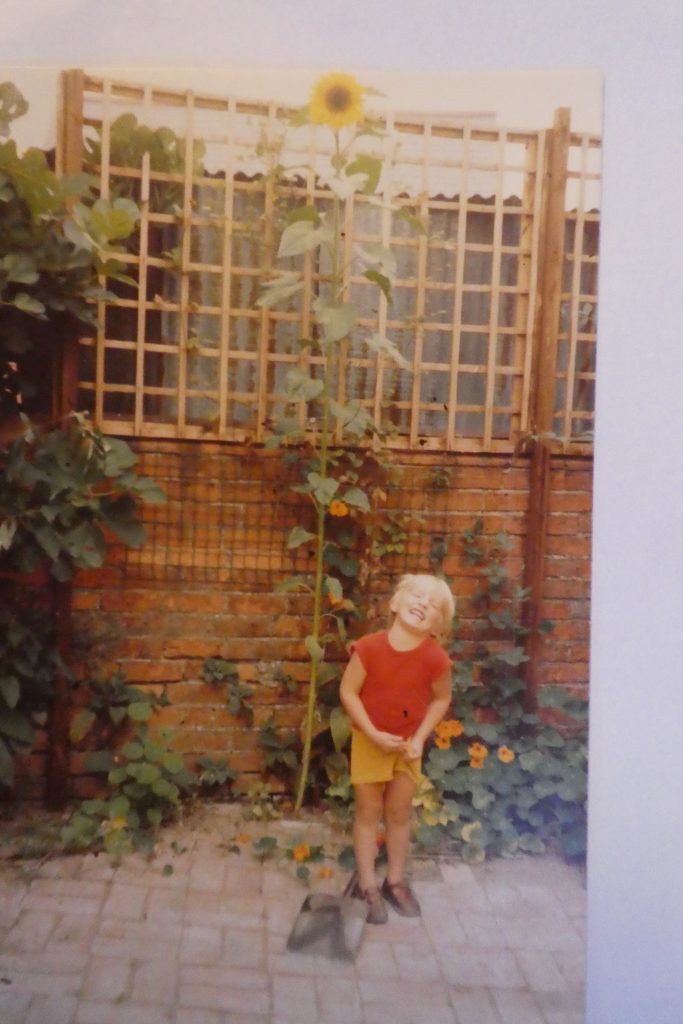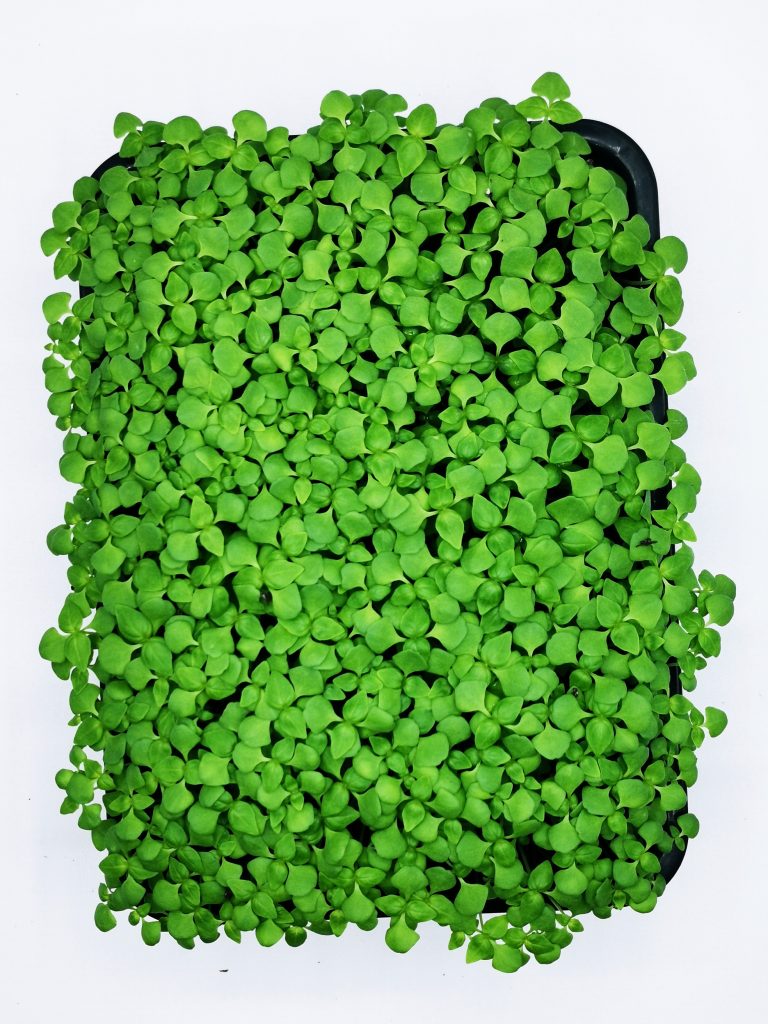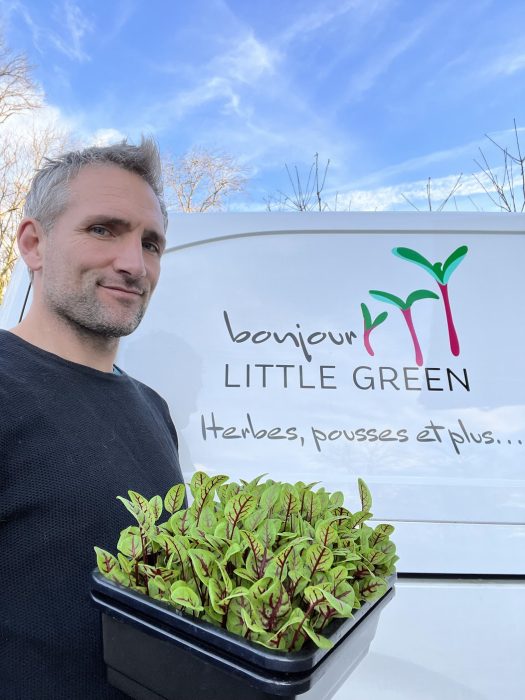In line with tomorrow’s vegetarian tasting menu event, we chatted with Hotel du lac’s microgreen supplier, Sam Golcher.
How did you come up with the name?
The products are all small and primarily green so we thought Little Green. However, on trying to register Little Green, we discovered another company in France that has that name (they’re unrelated and work in textiles). My wife’s French and I’m English. We know that the French like to play on words with the English language, so we added Bonjour. We knew that French chefs would still understand the Little Green part and we just wanted chefs to be interested in something small that grows that can enhance their plates.
In fact, the English call me Bonjour Little Green and the French just call me Little Green. They omit the Bonjour bit. Maybe it’s a bit kitch for them. I like how they say Little Green with their French accent, it’s quite cute!
What is your background?
The family veg patch
To take it right back, I grew up with parents who had a vegetable patch. So we would fairly regularly eat produce from the garden. Occasionally we had some lambs and they would go off to the big farm and then the freezer would get full of nice lamb chops. So I grew up around horticulture, but on an amateur basis and seeing mum and dad gardening and appreciating a productive garden and also eating fresh vegetables.

Travelling and the Big Smoke
I studied town planning and urbanism at university, then I went traveling. I taught English as a foreign language in Australia, a water sports instructor in the Caribbean, then when I was about 26 I thought I’d do a proper job. So I went to London for three and a half years and was in IT recruitment for three years.
I got a bit bored of London and realised I didn’t want to I live in a city all my life. But then I got a promotion… so I resigned! I looked at some of the pale, slightly podgy 40-year-old men around me and thought, I don’t want that to be me. So I quit London and went to America, where some of my French friends I’d met in Oz were travelling. We traveled Highway one. When we got to the end they went back to Chatel. I didn’t speak French so decided to go to Morzine as I knew it had lots of English-speaking visitors. I blagged a job as a chalet chef and did my first season with Snow&Trek. Then I returned to London thinking, okay, I’d got my midlife travelling crisis out of the way.
Back to France
I did another eight months in London then realised I was done. So I came back here and I did another couple of seasons. I found Morzine particularly British and that wasn’t super appealing to me actually as I was really trying to learn French. So I went to a season in Chatel with my French friends. That’s where I met Amélie, who’s now my wife.
Marco Pierre White
A friend of mine’s a photographer in the UK and he photographs Marco at Pierre White’s restaurants, both the restaurant itself and the food shoot. Some of the chefs asked him if he photographed small farms or big farms who grew good products, particularly microherbs. So my friend Dan said no, I don’t, but why? And they said because we’re always looking for them.
They said they had a few supplies, but they’d run out. At a Michelin star level, when something is on the menu, even something as small as microherbs, it needs to be on the plate. At that level of styling, it’s not an option. So he rang me up and he said, “Sam, you’ve got to do this.”
And I said no, for about 18 months I think. But it started playing on my mind. I’d messed around with micro-greens like broccoli shoots and pea shoots when I lived in London, just on my windowsill; just to have fresh stuff for myself. It’s not super difficult to do.
The experimental beginnings
So I bought a few trays and started messing around, and then I quite liked it and I thought, okay, I’ve got a house, we’ve got an empty basement. So I thought if I do want to do this I have a space to do it in. Then I spoke to a couple of chefs that I knew here, and they said yes we need that. They said that there’s the odd bit here and there, but it’s hit or miss as to whether they’ve actually got it every week.
Then Amélie, my wife, who has a lot of people come in front of her as she’s an osteopath, started speaking to the chefs and the restaurant owners, and they all said yes. Yes!
So I started doing it and started going to see people and every chef, even up to now, I’ve ever met has said it’s brilliant. If they use it, they take it. If they don’t use it, primarily in traditional restaurants, they say it’s great but it’s not what we do.
So that’s how I got to where I am today!
How did the relationship with Hotel Du Lac come about with Tambo?
There are lots of Scottish chefs around here. I actually know Alan from Alba from way back (it’s a very long story) and got reintroduced to him out here. I also worked with Chiefy [who Tam mentions in his interview] and Kayleigh from Black Stag. I asked him if he would be interested? He said he would, but that he’s a bit traditional so he’d want herbs rather than vegetable shoots. It didn’t match the style of food he did at the last place he was at but at Hotel du Lac it works perfectly.
How long does it take to grow a tray of microherbs?
The shortest is eight days and the longest is about 35 days. For example, micro mint and red vein sorel and the longer growers and, depending on the temperature, can take 30 to 35 days. But different chefs will have different requirements for how micro they need them. At the Michelin level they want them micro as small as possible. They have the time to get their tweezers out to dress a plate. Whereas in some of the faster paced restaurants, they don’t have time. So they want them a bit bigger so they can pull them off and maybe use as a garnish, rather than adding a single leaf to a delicate gateau.

What’s the difference between a micro herb and a micro green?
I don’t give official horticultural advice, but to my mind microherbs generally refers to aromatic herbs, such as sage, basil, rosemary, thyme. The micro greens are essentially mini vegetables. So they’re broccoli shoots, sunflower shoots, pea shoots, kale, that sort of thing. Things that would grow to be a proper big vegetable as opposed to a herb. There’s not a miniature version of the vegetables. It’s just the start of the growth. If you grew any of my products to adult, it would become a broccoli or a cauliflower or whatever.

How does the nutritional content differ from a full-sized vegetable?
I’m not a scientist but there was a study done at the University of Maryland in the US, and their research ultimately discovered that the microgreens contained four to 40 times more nutrients than their mature counterparts. So as they grow bigger, their nutrients dilute across the whole plant. So if you take 10 grams of broccoli shoots and put them in a sandwich, you’re probably getting as much as if you ate a whole adult broccoli stem. Maybe that’s why some people call them a superfood. I don’t think there’s such a thing as a super food. There’s just food. And some food is better for you than others! And if it’s not processed, it’s probably good.
Where did the pea shoot phenomenon come from?
Peas are relatively cheap to buy in large quantities. If you’re buying 25 kilogram sacks of peas, you’re getting a good price. They’re relatively easy to grow too. They have tendrils which stick out, so they can pad out a salad. They taste like pea, which is sweet and sugary. You stick that with a bitter salad leaf and you’ve got a salad, you’ve got texture, you’ve got flavours. Because of the tendrils a chef at any level cut one, put it on a plate, and it makes the plate stand out. And I guess peas are something that people see as safe and easy.

What’s your zero waste policy?
The trays I use are made from recycled plastic which can be recycled again. I use organic potting compost in the trays. The chefs leave the soil in the trays which I pick up and compost, so everything gets reused. Also, I try to grow to order. I ask chefs to tell me what they want that will go with their menu. They tell me we work out roughly how much they’ll need and I grow more if they are expecting a busy week. The chefs like it because when the products arrive, they use a hundred percent of it.
Who is your biggest competitor?
My biggest competitor is massive company in Holland, and they package everything in Holland. It then gets sent to a depot, then loaded onto a truck, possibly goes to another demo before it goes out to the chefs. These things don’t deal well with big changes in temperature. And they go off pretty quickly…
What can people grow at home for themselves?
If you want nice salads, I’d do the easy things. Everybody likes pea shoots almost. I don’t know anyone that doesn’t like peas! You know, just like normal peas on a, so grow pea shoots, they taste of peas. They’re relatively easy to grow. Then maybe get some broccoli and kale. If you put them in a salad, all the flavours get mixed up and they’re super healthy. If you’re just trying to grow a little bit you want some flavour and some nice colours. It’s good to get your nutrients this way because the veg and the salad you get at the supermarket isn’t nutritious as we’d hope. I may offer grow your own box sets next summer, I just need to work out the logistics.
Final question, who is your favourite Disney character?
Now there’s a question! I would suggest it’s Mowgli, I think of it French, from The Jungle Book. He lives in a jungle and he lives with the animals and there’s not many humans involved. So it’s kind of like escaping the city and he’s surrounded by trees and greenery. I’m, I’m a big believer in trees. Trees. Plant trees! We’ve got to plant trees.

